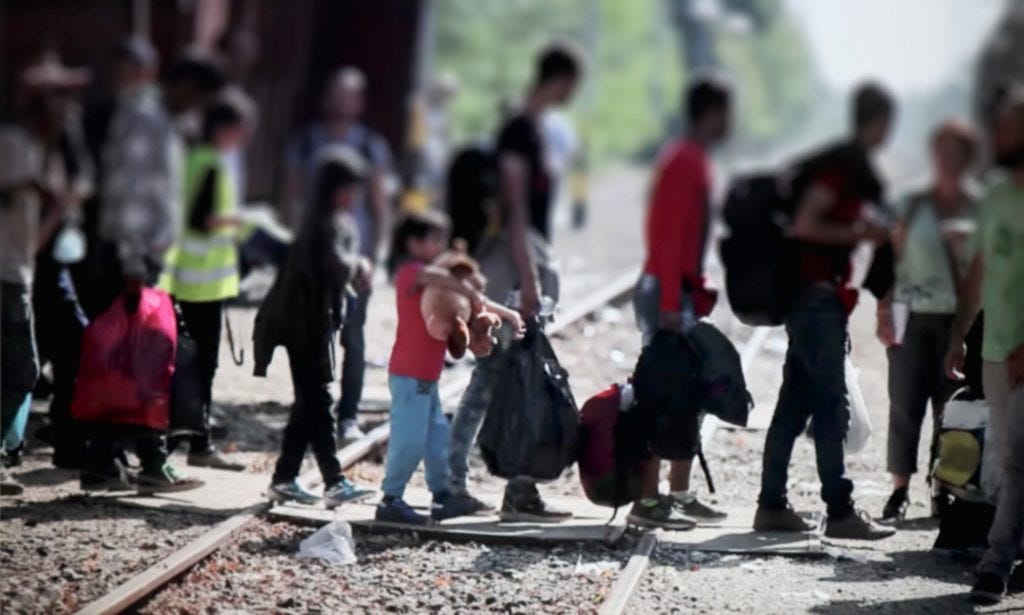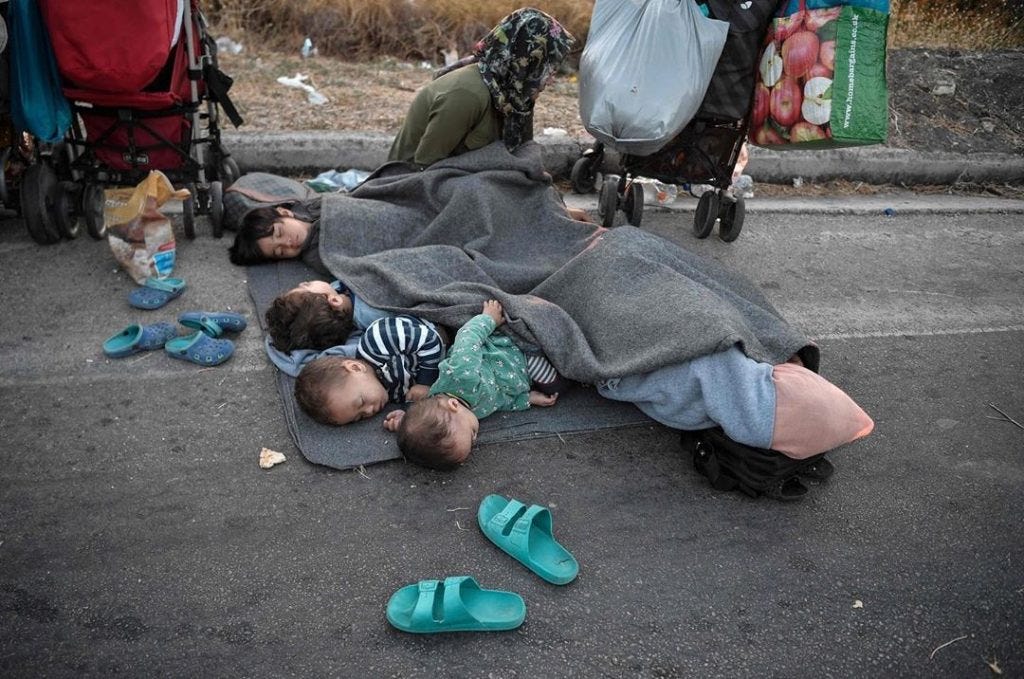Women and children last...
Fifty per cent of Gaza's residents are children. More than 2,000 of them now lie dead.
This is a monthly free newsletter from The Flock with Jennifer Crichton. If you would like to receive weekly updates, threads, access to our full back catalogue and more, please do consider signing up as a paid subscriber and supporting the work that goes into this platform…

How are you feeling? Heavy? Hopeless? Fearful?
I understand. The images emerging from Palestine this week are tough to take, the Islamaphobia and anti-semitism following in their wake even harder to witness. It’s impossible to know what to do with ourselves, much less how to help.
The news is unbearable, but the bombardment of civilian targets in Gaza in retaliation for the actions of Hamas needs to be witnessed, the facts understood.
The shocking October 7 attacks by Hamas and other militant-groups killed more than 1,400 Israelis and foreign nationals, according to Israeli officials. In total, 220 civilians, including women and children as well as soldiers, were taken into Gaza as hostages. Many are still being held today.
On that day, Israel’s Security Cabinet declared a state of war, and within 24 hours announced a complete siege of Gaza, blocking the entry of all goods, including electricity, water, food and fuel.
Since then, around 7,000 Palestinians have been killed, including over 1,100 women and 2,900 children, as well as journalists, medical workers and first responders. This week, myself and my colleagues here were horrified and devastated by the news that the wife, children, grandson, nephew, niece and other relatives of Wael AlDahdouh, Al Jazeera’s Gaza reporter, were killed in an air strike in central Gaza.
One million Palestinians have now been displaced, with schools and hospitals sheltering them hit, prompting United Nations Secretary-General António Guterres to issue a stark reminder to the international community: “Even war has rules”.
Those rules, of course, prohibit the collective punishment of civilians. Yet the Israeli response to Hamas’ assault is nonetheless hitting ordinary people on a scale that is hard to comprehend, especially so for those understandably unfamiliar with the intricacies of life in the Occupied Palestinian Territories (OPT). How, many are asking, can one people deny another access to water?
The picture is complex but according to Amnesty International and other organisations on the ground, since June 1967, the Israeli military authorities have had complete power over all water and water-related infrastructure in the OPT. In November that same year, the Israeli authorities issued a military order banning Palestinians from constructing any new water installations or otherwise extracting water without first obtaining a permit from the Israeli army - permits which are near impossible to obtain.
The UK and USA say Israel has the right to defend itself. And yet, as Gaza’s people remain deprived of even the most basic aid, western leaders and others from around the world remain focussed on semantics. On Wednesday, Russia and China vetoed a United States resolution calling for a “humanitarian pause”, saying they wanted a “ceasefire” - a wording which was vetoed by the United Kingdom and the US.
These are more than just words. Until an agreement is reached, civilians in Gaza not killed by bombs will remain at risk of dehydration, hunger and ill health as the territory remains deprived of medications, food, fuel and water.
This week, I signed up to help with aid operations here in the UAE. Within two hours of a call being issued for volunteers, all spaces were filled. Days later, the warehouses were the same, the community response utterly overwhelming. And yet, today, I’ve been told my shift tomorrow is cancelled - with aid not making it into Gaza, there is no room left for donations, no space for more boxes to be packed.
It is a devastating and dire situation and one that I am still learning about myself every day. But what I do know, what we all need to know, is that innocent people are dying in the most horrific way imaginable.
Last week, I asked you what you felt I could help with here in this newsletter. Overwhelmingly, you told me you want to understand more about the history of the conflict. To that end, I have already begun working with some friends and contacts in the Palestinian diaspora here to bring you nuanced, real, lived experience of life in the OPT. In the meantime, I am republishing below an extract of a piece of work first published on The Flock in the wake of the Russian invasion of Ukraine. I wish it wasn’t the case - but this story, by writer Lauren Crosby Medlicott, remains as pertinent today as it was then.
In war, women and children come last
Of the 82.4 million people currently displaced from their homes across the globe, 80% are women and children. Their displacement, whether internally or internationally, puts them at risk of gender-based violence, exploitation, discrimination and poor access to vital health services.
“War is indiscriminate and targets men and women in different ways,” Suzy Madigan of Care International tells me. “While men involved in fighting will suffer combat violence, women face a spectrum of risks, whether trapped or trying to find refuge across borders. Authorities and humanitarian responders will need to analyse the needs of different women and girls, and work hard to secure them the protection they need.”
Image: Shutterstock
In a recent interview on BBC Woman’s Hour, Madigan elaborated on this picture to explain how domestic violence is often not considered when we think about the cost of war. “One of the really big impacts of any conflict or disaster is domestic violence – it can rapidly increase,” she explains. “When men are going off to conflict and then coming back to communities, often that violence they have experienced can translate to violence at home.”
Evidence suggests that intimate partner violence is the most common form of violence against women in any conflict-affected area. Reports show 57% of women in the DRC have endured domestic violence throughout the country’s years of conflict. Where there is conflict, there will almost always be increased levels of domestic abuse, especially in countries where women’s rights are already at stake.
Increasingly, women and girls are being targeted for sexual violence in war, either as a result of general lawlessness or as a planned tactic – a weapon used by forces to terrorise and destroy communities.
“As a survivor of the genocide in Rwanda, I live with the lasting trauma of war,” says Alphonsine Kabagabo, director of Women for Refugee Women. “In the genocide, and in other wars across the world, women’s bodies become the target of horrific violence such as rape and torture. Our families and our lives are torn apart. Just the fact of being a woman exposes you to sexual violence.”
During the Bosnian war, up to 50,000 women were raped. In the Rwandan genocide, there were an estimated 250,000 instances. It’s an expression of aggression, an extension of the battlefield, a way to humiliate and weaken the morale of a community, and it occurs time and again in conflict situations.
When a woman is in a situation where she is suddenly reliant on other people for her basic needs, she is immediately made very vulnerable. “When there is an imbalance of power and a desperate need for survival, often there are people who will take advantage of that,” Madigan explains. If a mother is escaping from a conflict zone – with her children but without any money, transport, protection or food – she is forced to rely on the offers of people she doesn’t know or trust. To survive, she is made completely dependent on other people, some of whom will take advantage of the fact she is a woman.
As a result, women and girls who have been forcibly displaced are at particular risk of trafficking. They may be held as military sexual slaves, labourers or even as combatants, and are all the more vulnerable when fighting to keep both themselves and their children alive.
“People become empowered and are less vulnerable when they have choice and financial independence,” Madigan says, explaining that solutions to mitigate the risk of exploitation involve “looking at all the elements that make people vulnerable, make them reliant on others and take away their choice and independence. That is where we put in protection measures and give them power.”
In times of conflict, essential health services are often severely disrupted – yet, it is a time when access to adequate healthcare is particularly pertinent for women. Increased sexual abuse brings a greater risk of unplanned pregnancies and sexually transmitted diseases, while exposure to conflict increases the risk of maternal death through the deterioration of the health care system, higher rates of unsafe abortion, shortages of skilled health professionals, malnutrition and increased risk of infection. For women on the move, maintaining personal hygiene can become increasingly difficult and menstruation can be particularly distressing amid a lack of basic facilities and clean water. Mental ill health is common too, with trauma and stress often presenting as PTSD.
Image: Unsplash
However strong women fleeing conflict may be, war presents difficulties they sometimes cannot rise above – and that is when the international community must step in. In emergency situations, we can respond by creating safe spaces and routes for women to claim asylum.
“Every day I speak with women who are struggling to access protection because the government doesn’t believe them and instead forces them into destitution or locks them up in detention centres,” says Kabagabo. “They cannot begin to heal because our government doesn’t let them.”
“Whatever dangers women are fleeing, they can never be sure that safety lies ahead. And yet time after time, women show that resilience in conflicts and disasters,” says Madigan. “It takes phenomenal courage to take your children and leave your home to get to a border, with no certainty about what comes next.”







Thank you Jen x
Thanks so much Jen, I really do appreciate this x